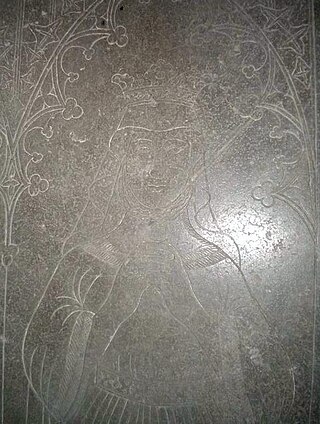Related Research Articles
Year 1359 (MCCCLIX) was a common year starting on Tuesday of the Julian calendar.
The 1350s was a decade of the Julian Calendar which began on January 1, 1350, and ended on December 31, 1359.

Sture was a name borne by three distinct but interrelated noble families in Sweden in the Late Middle Ages and Early Modern Period. It was originally a nickname, meaning 'haughty, proud', but later became a surname. Particularly famous are the three regents from these families who ruled Sweden in succession during the fifty-year period between 1470 and 1520, namely:

This is a list of governors for Stockholm County of Sweden. Stockholm County separated from Uppland County, the first time from 1641 to 1654, and then finally in 1719. The City of Stockholm was separately governed by the Governor of Stockholm until 1967, when it was integrated into Stockholm County. The governors reside in Tessin Palace.
The Governor of Stockholm was the head of the Office of the Governor of Stockholm, and as such he was the highest Swedish State official overseeing the affairs in the City of Stockholm between 1634 and 1967. The Governor was the equivalent in Stockholm of a county governor elsewhere in Sweden.

Eric "X" was the King of Sweden between 1208 and 1216. Also known as Eric the Survivor, he was, at his accession to the throne, the only remaining son of King Canute I of Sweden and his queen. The name of his mother is not known, but may have been Cecilia.

Eric XII was King of Sweden and lord of Scania in 1344–1359. He was a co-ruler with his father, King Magnus IV, from 1356 until his death in 1359.
Petrus Filipsson, also known as Peder Filipsson Röde, was a Swedish Dominican friar and Archbishop of Uppsala from 1332 to 1341.
Admiral (Adm) (Swedish: Amiral, Am) is a four-star commissioned naval officer rank in the Swedish Navy. Admiral ranks immediately above vice admiral and is equivalent to general.
Charles of Tofta, Swedish: Karl Ulfson, Sparre av Tofta was a 14th-century Swedish magnate and High Constable of Sweden.

Richeza of Denmark was Queen of Sweden as the wife of King Eric X, and the mother of King Eric XI.

Falkenberg (Falkenbergshus) was a fort located at Falkenberg in Halland County, Sweden. The fortification was located on the south strand of the river Ätran, about 60 m (200 ft) from the southern abutment of Falkenberg Bridge. It would later give name to the town of Falkenberg which was previously known as Ätraby.

Adolf Arnold Louis Palander af Vega was a Swedish naval officer, mostly remembered as the captain on Adolf Erik Nordenskiöld's Vega expedition, the first successful attempt to navigate the Northeast Passage.
Beatrice of Bavaria ; Swedish: Beatrix; was Queen of Sweden as the consort of King Eric XII of Sweden (1339–1359) who co-ruled Sweden with his father King Magnus IV.

The Embassy of Sweden in Moscow is the chief diplomatic mission of Sweden in the Russian Federation. It is located at 60 Mosfilmovskaya Street, on the corner of Ulofa Palme Street, in the Ramenki District of Moscow.

Helga de la Brache, née Aurora Florentina Magnusson,, was a Swedish con artist. She obtained a royal pension by convincing the authorities that she was the secret legitimate daughter of King Gustav IV of Sweden and Queen Frederica of Baden.

Edward Balliol or Edward de Balliol was a claimant to the Scottish throne during the Second War of Scottish Independence. With English help, he ruled parts of the kingdom from 1332 to 1356.

Görvel Fadersdotter (Sparre) was a Swedish noblewoman and county administrator. She was a major landowner in Denmark, Norway, and Sweden.

The Minister for Civil Service Affairs, since 2010 called Minister for Public Administration, is a member of the Government of Sweden. The minister for civil service affairs was the head of the Ministry for Civil Service Affairs from 1840 to 1996. It was reintroduced as a minister without portfolio post in 2010. Its tasks includes government procurement and an overall responsibility for municipalities and regions.
References
- Ebrey, Patricia Buckley, 1947-. - The Cambridge illustrated history of China / Patricia Buckley Ebrey.. - 2023 - Third edition.. - ISBN 978-1-009-15142-9
- Hammond, Matthew (2019). "The Acts of Edward Balliol, king of Scots (1332–56)". The community of the realm in Scotland, 1249–1424. Retrieved June 15 2023.
- McKisack, May (31 December 1959). The Fourteenth Century 1307–1399. Oxford History of England. Vol. 5. Oxford: Clarendon Press. ISBN 978-0-19-821712-1 OL 26141653M .
- (Swedish) Svenskt biografiskt lexikon [Elektronisk resurs] SBL. (2012-). Stockholm: Svenskt biografiskt lexikon
Tillgänglig på Internet: Svenskt Biografiskt Lexikon